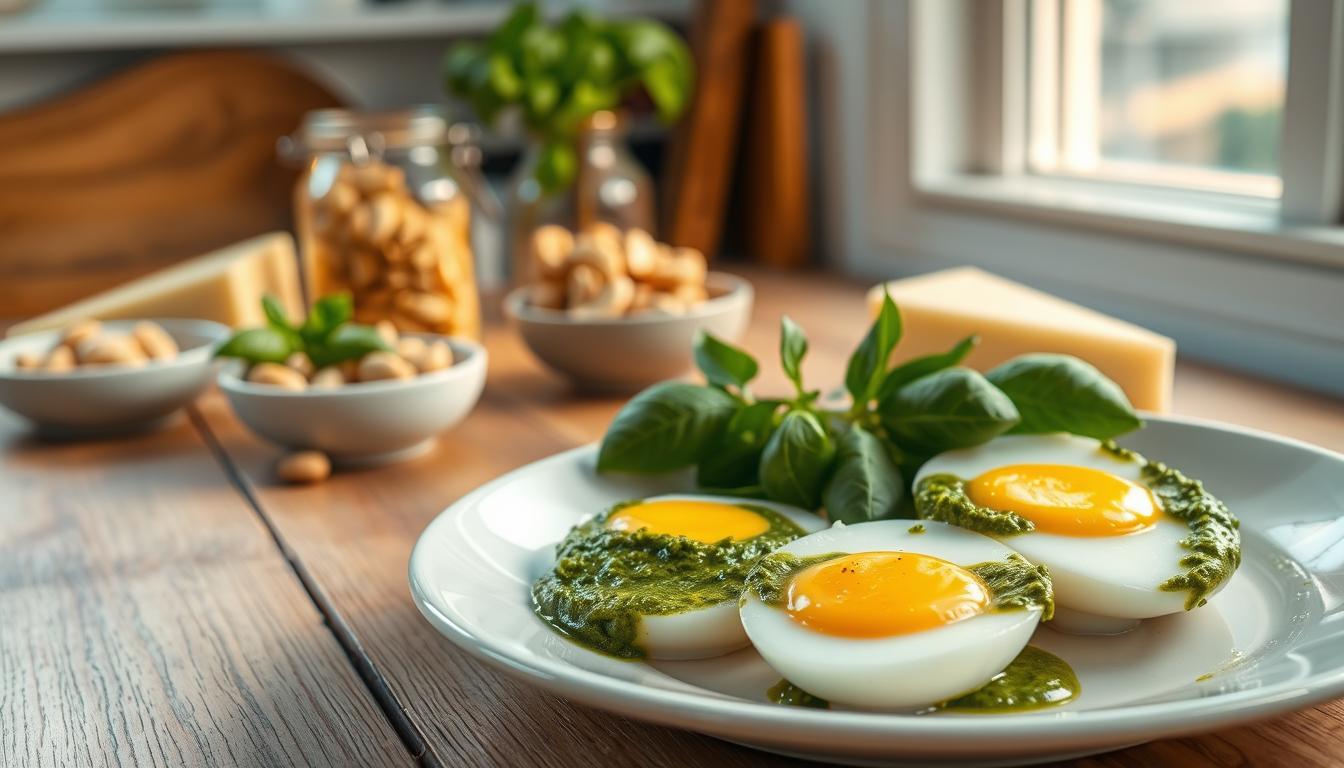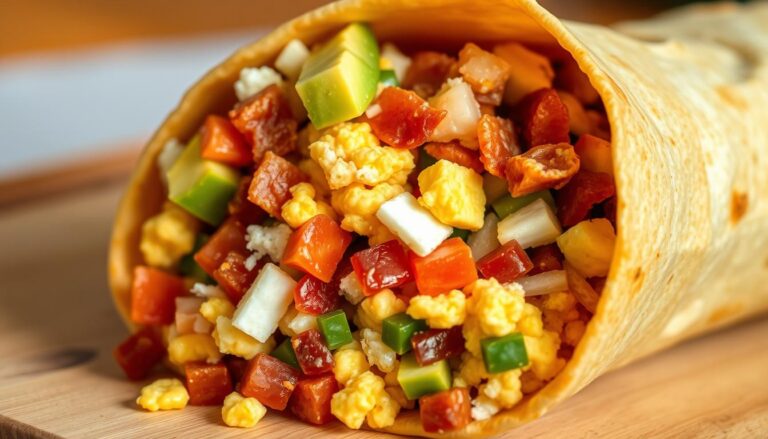Pesto Eggs Recipe: Elevate Your Breakfast
Table of Contents
Start your day with a dish that’s both tasty and healthy. Pesto Eggs are a hit on TikTok. They mix homemade pesto with fried eggs, often on avocado toast.
Make your breakfast better with this easy breakfast idea. Cooking eggs with pesto adds flavor and nutrition to your morning.
Ready to try it? This easy-to-make recipe will quickly become a favorite.
Key Takeaways
- Learn how to make a delicious Pesto Eggs Recipe
- Discover the benefits of using pesto in your breakfast
- Get inspired by new breakfast ideas using pesto
- Understand the ease of preparation of this recipe
- Explore the nutritional benefits of Pesto Eggs
What Makes Pesto Eggs Unique?
Elevate your breakfast with the vibrant flavors of pesto eggs. This dish is both healthy and delicious. It’s not just a tasty twist on a classic breakfast; it also brings many benefits.
The Flavorful Twist of Pesto
Pesto adds a rich, herby flavor to eggs. This makes them more exciting than a plain omelette or scrambled eggs. The basil, garlic, and olive oil in pesto create a delicious pesto egg recipe that’s sure to become a favorite.
Health Benefits of Pesto
Pesto is not just flavorful; it’s also packed with nutrients. The basil in pesto is rich in antioxidants. Garlic provides numerous health benefits, including improved heart health. By using pesto instead of butter or oil, you’re making a healthier choice, contributing to healthy pesto eggs.
A Versatile Breakfast Option
One of the best things about pesto eggs is their versatility. You can enjoy them on their own, paired with toast or a bagel, or as part of a larger breakfast spread. Whether you’re looking for a quick breakfast on-the-go or a leisurely weekend brunch, pesto eggs are a great choice, making them a perfect pesto eggs breakfast option.
Incorporating pesto into your eggs is a simple way to add flavor and nutrition to your breakfast. With its numerous benefits and versatility, it’s no wonder that pesto eggs are becoming a popular breakfast choice.
Ingredients You’ll Need
A delicious Homemade Pesto Eggs recipe starts with quality ingredients. You’ll need the basics for the pesto and eggs. Plus, some optional add-ins for extra taste and nutrition.
Essential Ingredients for Pesto Eggs
For a classic Pesto Eggs recipe, you’ll need:
- Eggs: Fresh eggs are crucial for the best taste and texture.
- Pesto: Homemade or store-bought pesto is a key component. For homemade pesto, you’ll need basil, garlic, pine nuts, Parmesan cheese, and olive oil.
- Toast or Bread: A crusty bread or toasted slice is necessary for serving.
Fresh Ingredients for Best Flavor
Using fresh ingredients is key for the best flavor in your Pesto Eggs. Fresh basil, high-quality Parmesan cheese, and fresh eggs make a big difference. Freshness is key to a vibrant and delicious pesto, so try to use ingredients that are as fresh as possible.
Optional Add-Ins and Variations
You can customize your Pesto Eggs with various optional add-ins. Consider adding:
- Avocado: Sliced or diced avocado adds a creamy texture.
- Tomatoes: Cherry tomatoes or sliced tomatoes can add a burst of freshness.
- Cheese: Additional cheese like mozzarella or feta can enhance the flavor.
These add-ins let you create variations that suit your taste. Pesto Eggs become a versatile breakfast option.
Step-by-Step Cooking Instructions
Now that you have all the ingredients ready, let’s dive into the step-by-step process of making delicious Pesto Eggs. This recipe is straightforward and easy to follow. You can enjoy a tasty breakfast without much hassle.
Preparing the Pesto
Start by preparing your pesto. If you’re using store-bought pesto, you can skip this step. But if you’re making it from scratch, combine fresh basil leaves, garlic, pine nuts, Parmesan cheese, and olive oil in a blender or food processor. Blend until you achieve a smooth, vibrant green sauce. Adjust the garlic and cheese to taste.
Cooking the Eggs Perfectly
To cook the eggs, heat a non-stick skillet over medium heat. Add a couple of tablespoons of your prepared or store-bought pesto to the skillet. Once the pesto is heated and slightly sizzling, crack in your eggs. Cooking the eggs in the pesto infuses them with its rich flavor. Cook until the whites are set and the yolks are cooked to your desired doneness.
Combining Pesto and Eggs
The beauty of Pesto Eggs lies in the simplicity of combining the two main ingredients. As the eggs cook in the pesto, they absorb the flavors, creating a deliciously aromatic breakfast. Once the eggs are cooked, remove them from the heat. You can serve them directly from the skillet or transfer them to a plate. Consider garnishing with additional basil or Parmesan for extra flavor and visual appeal.
By following these steps, you’ll be able to create a mouth-watering Pesto Eggs dish that’s sure to impress. Whether you’re cooking for yourself or serving a crowd, this recipe is sure to become a favorite.
Tips for Perfectly Cooked Eggs
To make your Pesto Eggs breakfast better, learning to cook eggs well is key. The right eggs can turn a simple dish into a delicious Quick Pesto Eggs meal.
Choosing the Right Cooking Method
How you cook your eggs matters a lot. You can fry, poach, or boil them, depending on what you like and the texture you want.
- Frying eggs gives you a crispy edge and a runny yolk if done right.
- Poaching makes eggs soft and delicate.
- Boiling eggs cooks them fully and simply.
Adjusting Cook Time for Desired Texture
Using eggs at room temperature helps them cook evenly. It’s important to adjust the cooking time to get the yolk just right.
| Cooking Method | Cook Time for Runny Yolk | Cook Time for Fully Set Yolk |
|---|---|---|
| Frying | 3-4 minutes | 5-6 minutes |
| Poaching | 3-4 minutes | 5 minutes |
| Boiling | 6-7 minutes | 10-12 minutes |
By picking the best cooking method and adjusting the time, you can get perfectly cooked eggs every time. This makes your Quick Pesto Eggs breakfast truly special.
Creative Serving Suggestions
Pesto Eggs are more than just a meal; they’re a blank canvas for your creativity. You can make this simple dish even more special by adding different sides and toppings. Here are some ideas to get you started.
Pairing with Toast or Bagels
Adding Pesto Eggs to toasted sourdough or whole grain bread adds a nice crunch. This texture contrasts well with the creamy eggs, making your breakfast more enjoyable. You can also serve them on toasted bagels for a unique twist.
Tips for Toast: Use a crusty bread or baguette for extra texture. For more flavor, sprinkle red pepper flakes or drizzle olive oil on top.
Adding Fresh Vegetables
Adding sliced tomatoes or spinach boosts both the taste and nutrition of your Pesto Eggs. These fresh veggies add color and flavor, making your breakfast healthier and more exciting.
- Cherry tomatoes halved or quartered
- Fresh spinach leaves
- Sliced bell peppers
- Grilled or sautéed mushrooms
Try different veggies to find your favorite mix. The goal is to mix flavors and textures well.
Serving with a Side Salad
For a lighter option, pair Pesto Eggs with a side salad. A simple green salad or a grain salad can enhance the Pesto Eggs’ rich taste.
Salad Ideas: Mix arugula with cherry tomatoes and a light vinaigrette. Or, combine quinoa with roasted veggies and citrus dressing. The warm eggs and cool salad make a great contrast.
By using these creative ideas, you can make a simple breakfast into a memorable meal. Whether you’re after healthy Pesto Eggs or just a new breakfast idea, these suggestions will inspire you.
Dietary Variations and Substitutions
Pesto Eggs can be made in many ways to fit different diets. You can make it dairy-free, gluten-free, or vegan. We’ll show you how.
Making It Dairy-Free
To make Pesto Eggs dairy-free, use dairy-free cheese instead of Parmesan. Vegan cheese or nutritional yeast work well. Nutritional yeast has a cheesy taste and is vegan-friendly.
Gluten-Free Options
For those with gluten issues, serve Pesto Eggs with gluten-free bread. Or, skip the bread and enjoy them alone or with gluten-free toast or bagels. This makes it easy to fit your diet.
Vegan Pesto Alternatives
To make vegan Pesto Eggs, replace Parmesan with a vegan option. Nutritional yeast is a good choice for its umami taste. You can also try other vegan pesto recipes with cashews or sunflower seeds for creaminess.
Here’s a quick comparison of the dietary variations:
| Dietary Variation | Substitution/Adjustment | Benefit |
|---|---|---|
| Dairy-Free | Use vegan cheese or nutritional yeast | Maintains cheesy flavor without dairy |
| Gluten-Free | Serve with gluten-free bread or skip bread | Easily accommodates gluten intolerance |
| Vegan | Substitute Parmesan with nutritional yeast | Achieves similar umami flavor |
With these simple changes, you can enjoy the Best Pesto Eggs recipe your way. Whether for yourself or a group, these options make it easy for everyone to love this tasty breakfast.
Storage and Reheating Tips
Keeping your Quick Pesto Eggs fresh is important. Whether you’re planning meals ahead or saving leftovers, the right steps will keep your eggs tasty. This is true even on the next day.
How to Store Leftover Pesto Eggs
To keep your Pesto Eggs fresh, put them in an airtight container in the fridge. This stops moisture from changing their taste and feel. It’s smart to keep the pesto sauce separate if you haven’t mixed it with the eggs. This helps keep the eggs from getting too soggy.
- Cool the eggs to room temperature before refrigerating to prevent condensation.
- Use a shallow airtight container to store the eggs, allowing them to chill more evenly.
- If you’re storing the pesto separately, consider using a small glass jar with a tight-fitting lid.
Reheating for Optimal Taste
When reheating your Pesto Eggs, do it gently. High heat can make them rubbery or overcooked.
- Reheat the eggs over low heat in a non-stick pan, adding a small amount of water or additional pesto if needed to maintain moisture.
- Or, you can reheat them in the microwave on a low setting, checking every 10-15 seconds to avoid overheating.
| Reheating Method | Tips | Benefits |
|---|---|---|
| Non-stick Pan | Add a little water or pesto | Maintains moisture, controls texture |
| Microwave | Heat in short intervals | Quick, convenient |
Common Questions About Pesto Eggs
Exploring Pesto Eggs might raise some questions. Let’s tackle the most common ones to help you make perfect Pesto Eggs.
Can You Meal Prep This Dish?
While Pesto Eggs are best fresh, you can prep parts ahead. Make the pesto sauce early and keep it in the fridge for a week. Crack eggs into a bowl, whisk, and chill overnight for a quick breakfast.
Tips for Meal Prep:
- Prepare pesto sauce in advance.
- Whisk eggs and store them in the refrigerator overnight.
- Store cooked Pesto Eggs in the refrigerator for up to two days and reheat as needed.
What Types of Pesto Work Best?
The pesto type greatly affects Pesto Eggs’ flavor. Traditional basil pesto is a favorite, but try sundried tomato, spinach, or roasted red pepper for a twist.
Popular Pesto Varieties:
| Pesto Type | Flavor Profile | Pairing Suggestions |
|---|---|---|
| Basil Pesto | Classic, herby, and slightly nutty | Pairs well with cherry tomatoes and mozzarella |
| Sundried Tomato Pesto | Rich, tangy, and savory | Complements grilled vegetables and goat cheese |
| Spinach Pesto | Mild, earthy, and refreshing | Works well with feta cheese and olives |
Can You Use Egg Alternatives?
Looking for egg substitutes? Tofu scramble or chickpea scramble work great in Pesto Eggs. They’re good for dietary needs and add a special touch to your dish.
Conclusion: Why You Should Try This Recipe Today
Starting your day with Pesto Eggs breakfast can change everything. This recipe mixes pesto’s rich flavors with eggs’ health benefits. It’s a great way to begin your morning.
Elevate Your Breakfast Routine
Pesto Eggs give a tasty twist to usual breakfasts. The pesto brings a fresh taste, and eggs add protein for energy all morning.
Make it Your Own
Don’t be afraid to try new things with this recipe. Whether you want a simple or fancy breakfast, Pesto Eggs fit the bill. Serve them with toast, bagels, or a salad for a complete meal.
FAQ
Can I meal prep Pesto Eggs?
What types of pesto work best for Pesto Eggs?
Can I use egg alternatives in Pesto Eggs?
How do I make Pesto Eggs dairy-free?
Are Pesto Eggs gluten-free?
How should I store leftover Pesto Eggs?
How do I reheat Pesto Eggs?
Can I customize Pesto Eggs with other ingredients?
Tried This Recipe? Share Your Thoughts!







